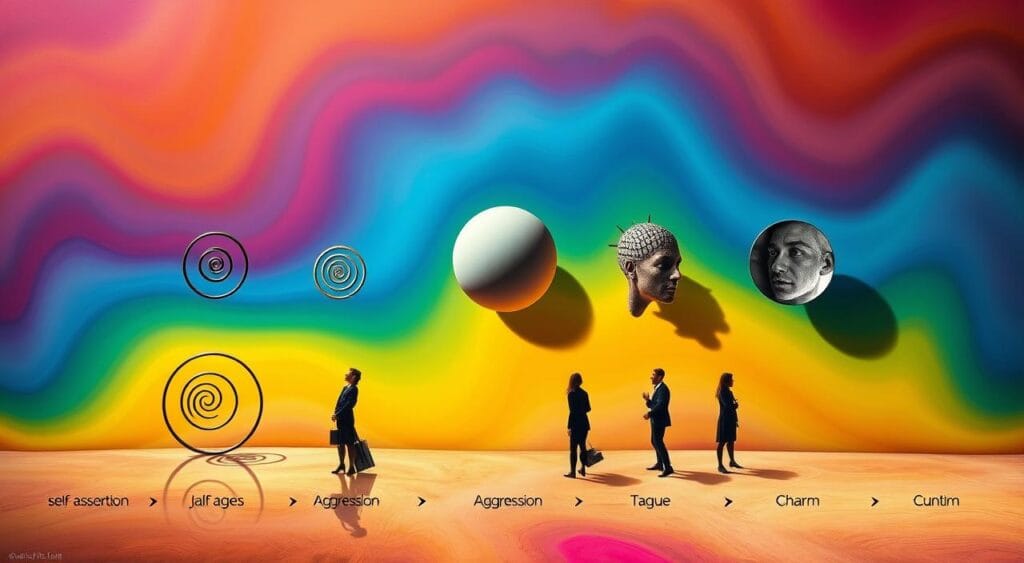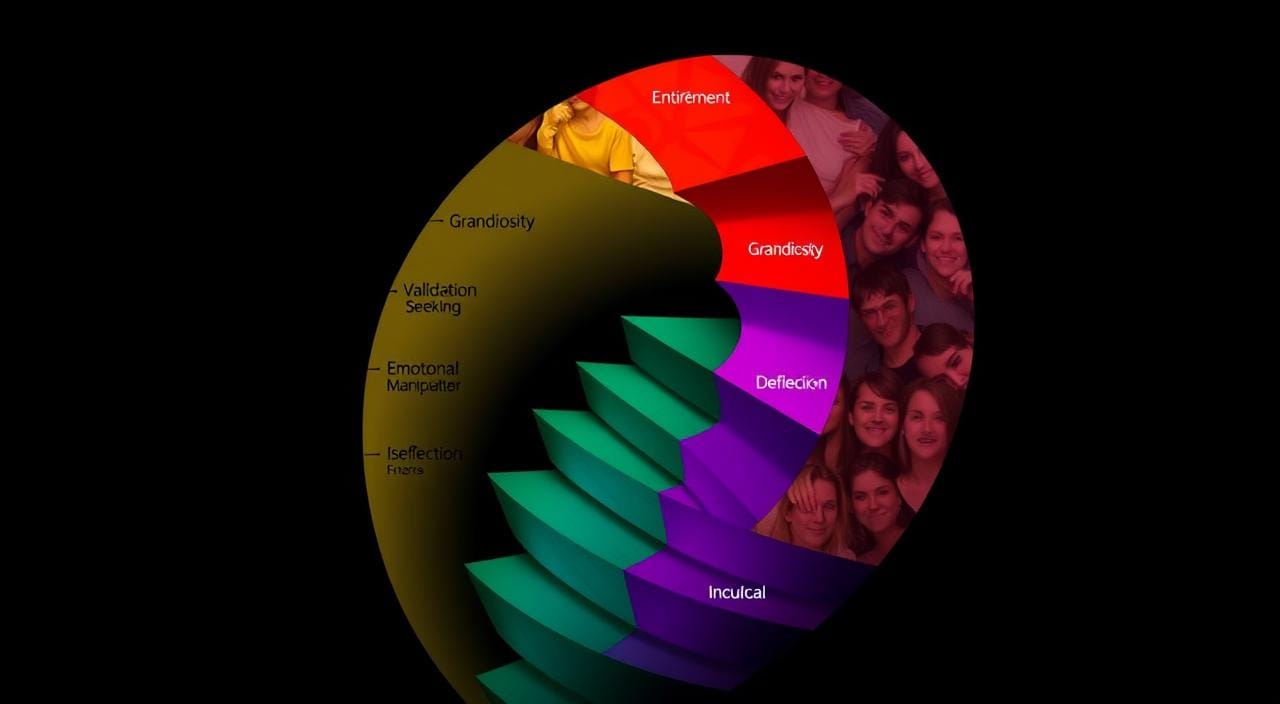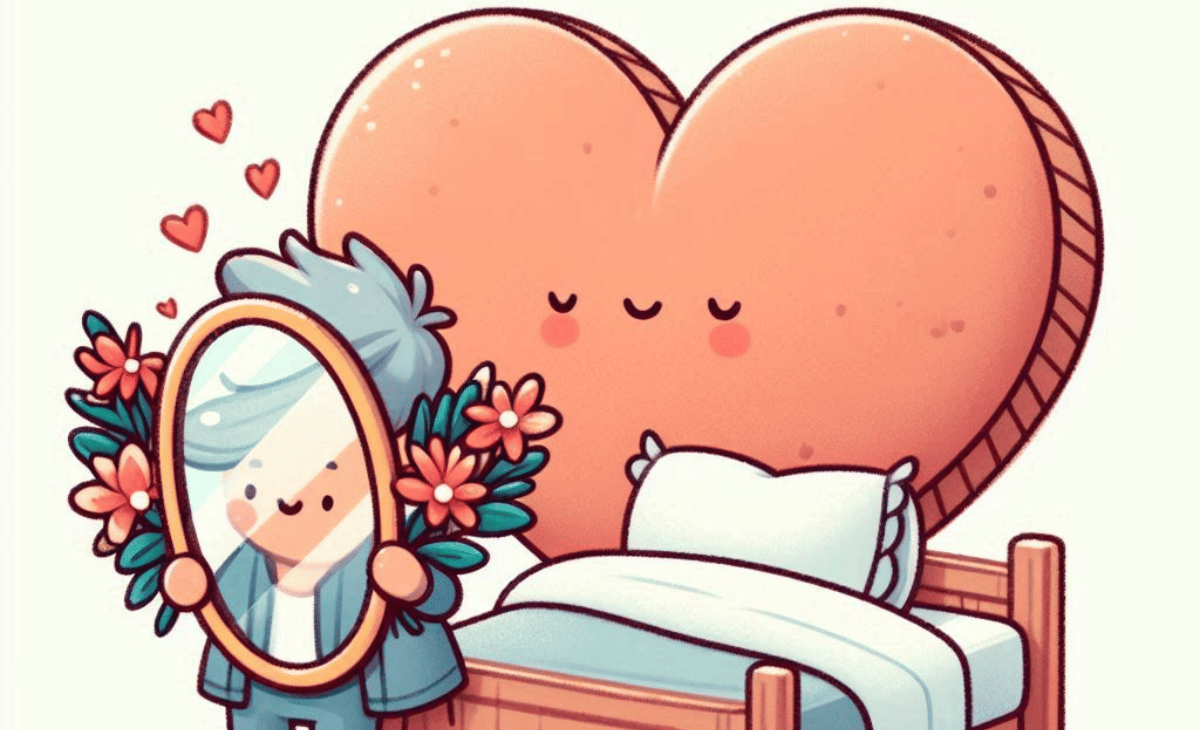We often meet people who think too much of themselves and don’t care about others. They might have Narcissistic Personality Disorder (NPD). Knowing the 7 stages of narcissism helps us spot and deal with their abuse and control.
Being in a relationship with a narcissist is like riding a wild rollercoaster. It starts with “love bombing,” where they shower you with love. But soon, they start to criticize and control you. The discard phase is especially hard, leaving you feeling lost and worthless. The “hoovering” phase, where they try to get you back, is very tricky.
Key Takeaways
- Narcissistic Personality Disorder (NPD) is a complex condition that can only be diagnosed by a psychiatrist and affects a small portion of the population1.
- People with NPD often don’t think they have a problem and are hard to help, with little chance of change without professional help1.
- Narcissistic abuse can cause serious harm, including mental health issues in victims if they’re exposed for a long time2.
- Spotting the signs of narcissistic abuse, like the idealization-devaluation-discard cycle, can help you escape these bad relationships2.
- Understanding the 7 stages of narcissism is key to understanding abusive relationships and starting to heal1.
What is Narcissistic Personality Disorder?
Defining Narcissistic Personality Disorder
Narcissistic Personality Disorder (NPD) is a mental health issue. It makes people think they are more important than they really are. They also need lots of praise and don’t care about others’ feelings3.
This disorder falls under cluster B personality disorders in the DSM-5. These disorders are known for dramatic, emotional, and unpredictable behavior3. Having some narcissistic traits is common, but NPD is more serious. It affects how someone sees themselves, their relationships, and their daily life.
Studies say up to 5% of people might have NPD3. Research also links narcissistic traits to violent crimes. Over 21% of inmates in one prison were diagnosed with NPD3. NPD can be caused by childhood trauma, genetics, and the environment3.
It’s important to understand Narcissistic Personality Disorder well. It can show up in different ways and deeply affect people and their relationships. Knowing what NPD is can help us deal with its challenges better.
Narcissistic Traits vs. Narcissistic Personality Disorder
Everyone shows some narcissistic traits now and then. But, there’s a big difference between having these traits and having Narcissistic Personality Disorder (NPD)4. NPD is a pattern of behavior that affects all parts of life. On the other hand, someone with narcissistic traits might only show these traits in specific situations4.
It’s also possible to have narcissistic traits without having NPD4.
The main difference is how much these traits affect someone’s life and how aware they are of their actions4. Someone with narcissistic traits might want admiration, but it doesn’t ruin their life or relationships4. In contrast, NPD makes it hard to have good relationships and live a normal life4. People with NPD also struggle with understanding themselves and others4.
| Narcissistic Traits | Narcissistic Personality Disorder |
|---|---|
| Occasional belief in being special or superior | Constant, pervasive sense of grandiosity and entitlement |
| Traits come and go, do not significantly impact life or relationships | Severely impairs ability to have healthy relationships and function in daily life |
| May exhibit some narcissistic behaviors, but does not meet full criteria for NPD | Meets criteria for a formal diagnosis of Narcissistic Personality Disorder |
| Generally higher self-awareness and empathy | Tend to lack self-awareness and empathy |
The DSM-5 TR shows how far someone is from what’s normal4. Healthy narcissism is good for skills like empathy and creativity4.

The Stages of Narcissistic Abuse
Navigating the complex dynamics of narcissistic abuse is a challenging journey for many. This pattern often follows a predictable path that can confuse and harm the victim5.
The Honeymoon Phase
The “honeymoon phase” is the first stage of narcissistic abuse. The narcissist showers the victim with love, attention, and validation. This is called “love bombing,” aimed at fulfilling the narcissist’s needs and drawing the victim in5.
During this phase, the narcissist mirrors the victim’s behaviors and interests. This creates a false sense of connection and understanding5.
The Fading Phase
As the relationship goes on, the narcissist’s attention and affection fade. The victim becomes clingy and desperate to get back the earlier affection. This “fading phase” is marked by emotional neglect, blame-shifting, and a drop in the victim’s self-esteem5.
The emotional roller coaster can be very traumatizing. It leaves the victim feeling confused, isolated, and trapped6.

Understanding the stages of narcissistic abuse is key to recognizing patterns. It helps in seeking the right support and resources for healing. Getting professional help and connecting with survivor communities is invaluable in this journey6.
7 Stages of Narcissism
Being in a relationship with a narcissist is very tough. It’s filled with emotional abuse and manipulation. Narcissistic abuse can last for a long time, keeping victims trapped in a cycle of anger and peace7. It’s hard to see the abuse, making it hard for victims to leave7.
- The Honeymoon Phase: At first, the narcissist seems perfect, showering the victim with love and false intimacy. Narcissists may love-bomb with gifts, compliments, and promises of forever8. This makes victims feel swept away by the charm7.
- The Fading Phase: As time goes on, the narcissist’s interest fades, causing emotional distance7. This is stage 2, when they think you’re hooked8.
- The Emotional Phase: Victims feel more emotions like anger and loneliness as the narcissist pulls away7.
- The Anger and Fighting Phase: Talking to the narcissist leads to more fights and the silent treatment7.
- The Self-Blame Phase: Victims start to blame themselves for the relationship’s problems, trying to fix it7.
- The Discard Phase: The relationship may end, with some narcissists keeping victims for their own pleasure. Others may discard them when bored7. After a breakup, narcissists might try to win you back8.
- The Rage and Peace Phase: Being with a narcissist can lead to a cycle of anger and peace. It’s a trap of abuse and manipulation7. Dealing with a narcissist can cause PTSD and long-lasting feelings of anxiety, shame, and depression8.
Knowing these stages is key for those facing narcissistic abuse. It helps them spot the patterns and seek help for their mental health7. Some narcissists fear commitment and may end a relationship suddenly, even after saying they’ll marry8.

“Narcissistic behavior can stem from genetic factors or severe childhood trauma, leading to repeated cycles of abuse in adult relationships.”7
By understanding narcissism’s stages, people can better handle these complex relationships. They can start healing and moving forward9. Getting help from therapists or counselors who know about narcissistic abuse is a good step towards recovery9.
Types of Narcissism
Narcissism comes in different forms, not just the obvious kind. There’s also covert narcissism10. Covert narcissists seem humble but crave attention and praise. They might act out in subtle ways10. All narcissists focus too much on themselves, don’t care about others, and can’t handle criticism.
Overt Narcissism
Overt narcissists are the most common type. They are aggressive, outgoing, and always seek attention10. They think they’re better than everyone else and often put others down11.
Covert Narcissism
Covert narcissists are shy and introverted. They use subtle ways to manipulate others10. They might struggle with anxiety or depression more than others10.
There are more types of narcissism beyond overt and covert. These include:
- Exhibitionist narcissists who show off their superiority and need constant praise11.
- Highly-sensitive narcissists who are very aware of others’ feelings but in a harmful way11.
- Sexual narcissists who focus too much on their own desires in relationships, ignoring their partner’s needs11.
- Victim narcissists who pretend to be submissive but avoid taking responsibility11.
- Malignant narcissists who are very cruel and lack empathy, sometimes showing signs of antisocial personality disorder11.
Malignant narcissists enjoy hurting others and see things in very black-and-white terms11. It’s important to set boundaries with them to protect yourself10.

“Narcissists believe they are superior to others, entitled to special treatment, and deserving of higher status and privilege.” – Dr. Ramani Durvasula
Knowing about the different types of narcissism helps us deal with them better. The Narcissism Exposed newsletter offers great advice and resources for handling these situations10113.
Other Types of Narcissism
There are more than just the well-known types of narcissism. Mental health experts have found several other kinds. Knowing about these different types helps us understand narcissism better.
Antagonistic narcissism is all about being competitive and arrogant. People with this type love to show off their status and power. They want to be seen as better than others3.
Research shows that some narcissistic traits can actually help people succeed. For example, feeling like you’re in charge can help in your career or school3.
Communal narcissism looks like being very selfless and caring. But really, these people want praise and recognition for helping others3. They act like leaders or heroes to get attention3.
Malignant narcissism is the worst kind. It mixes narcissism with being very aggressive and not caring about others3. People with this type can be very mean and aggressive12.
There’s also adaptive narcissism and maladaptive narcissism. Adaptive narcissism can be good in some ways. But maladaptive narcissism really hurts a person’s life and relationships3.
Knowing about all these types of narcissism helps us see how complex it is. It lets us understand and deal with narcissism in our lives better.

The many types of narcissism show we need a deep understanding of it11123.
The Cycle of Narcissistic Abuse
Narcissistic abuse follows a predictable cycle, trapping victims in a loop of love bombing, devaluation, and discard13. The abuser first showers the victim with love and attention, known as “love bombing.” Then, they suddenly stop, leaving the victim feeling confused and desperate13.
This cycle includes rage, peace, gaslighting, and the silent treatment, making it hard for victims to escape13. The abuser’s black-and-white thinking quickly changes from idealization to devaluation. This pattern is known as the cycle of abuse, as described by Lenore Walker (1979)1314.
Covert and female narcissists often use this cycle to control their victims14. Vulnerable narcissists may focus on emotional abuse, creating a push-and-pull dynamic that makes victims feel helpless14.
The abuser may use emotional abuse, control, and isolation to maintain power13. The discard phase, where the relationship ends abruptly, escalates the abuse. The abuser may also smear the victim’s reputation to “win”13.
The cycle repeats, with the abuser trying to lure the victim back through reconciliation or “hoovering”13. This is followed by a calm phase, before the cycle starts again1314.
It’s important for victims to understand this cycle to seek help and break free15. Resources like the National Domestic Violence Hotline and the Psychology Today Therapy Directory can offer support and guidance14.
Causes and Risk Factors of Narcissistic Personality Disorder
The exact causes of narcissistic personality disorder are still a mystery. But, it’s believed that a mix of factors like childhood trauma, genetics, and environment play a role1617. Abuse, neglect, or overly demanding parents might shape narcissistic traits later on17. Also, genetics might be involved since narcissism often appears in families16.
Narcissistic personality disorder isn’t as common as once thought. Yet, it affects between 0.5% and 5% of adults in the U.S., with men more likely to have it16. Earlier, it was believed to affect up to 6.2% of Americans. Now, it’s seen as less common than other disorders like borderline or antisocial personality disorders16.
| Causes and Risk Factors of Narcissistic Personality Disorder |
|---|
|
The causes and risk factors of narcissistic personality disorder are complex. Genetics and biology are big players16. But, early life experiences and the environment also matter a lot17. Knowing these factors helps in treating and managing the disorder.
“Narcissistic personality disorder (NPD) is a mental health condition where individuals believe they are superior to others, affecting around 1 to 6 people out of 100.”17
The DSM-5 doesn’t recognize different types of narcissistic personality disorder. But, symptoms can vary a lot among people16. There are ideas about different subtypes, like grandiose or vulnerable narcissism16.
Conclusion
Understanding narcissism and narcissistic abuse can be tough. It’s key to spot the patterns and stages of this harmful behavior. By knowing the warning signs and cycles, we can protect ourselves. We can also seek support and work towards recovery18.
Healing from narcissistic abuse is not simple, but it’s doable. We can regain our freedom and form better relationships. By seeking help from loved ones and local groups, we can face the hurdles. We can find the support needed to escape the toxic cycle18.
Knowing the stages of narcissism helps us make better choices in our relationships. It also helps us focus on our own well-being18. With determination and a focus on personal growth, we can beat the trauma of narcissistic abuse. We can then look forward to a brighter, more rewarding life19.
FAQ
What are the 7 stages of narcissism?
The 7 stages of narcissism start with “love bombing,” where the narcissist showers the victim with love. Then, the victim trusts and depends on the narcissist more. Next, the narcissist starts criticizing and gaslighting the victim.
After that, the narcissist tries to control the victim. The victim then feels a loss of self and becomes addicted to the narcissist.
What is narcissistic personality disorder (NPD)?
Narcissistic personality disorder (NPD) is a mental health issue. It makes people think too highly of themselves and need lots of praise. It affects their relationships and daily life.
NPD is part of the cluster B personality disorders in the DSM-5.
What are the key differences between narcissistic traits and narcissistic personality disorder (NPD)?
Narcissistic traits and NPD differ in how much they affect a person’s life. Traits might show up sometimes but don’t really hurt relationships. NPD, however, is always there and hurts relationships and daily life a lot.
People with NPD also don’t understand themselves or others well.
What are the stages of narcissistic abuse?
Narcissistic abuse has a pattern of phases. First, the narcissist loves and praises the victim to meet their needs. Then, they become distant, making the victim clingy and desperate.
What are the 7 stages of narcissism?
The 7 stages of narcissism start with the “honeymoon phase” and “fading phase.” The narcissist then becomes angry and fights, followed by self-blame. Finally, there’s the “end game,” where the narcissist either ends the relationship or keeps the victim trapped.
Throughout, the narcissist uses tactics like gaslighting and silent treatment to control the victim.
What are the different types of narcissism?
There are different types of narcissism. The “classic” type is obvious, needing lots of praise. Covert narcissists seem humble but still crave attention.
All narcissists focus too much on themselves, don’t care about others, and can’t handle criticism.
What are the other types of narcissism?
Besides overt and covert narcissism, there are other types. These include antagonistic, communal, and malignant narcissism. Experts also talk about adaptive and maladaptive narcissism.
Adaptive narcissism might be helpful, but maladaptive narcissism really hurts relationships and daily life.
What is the cycle of narcissistic abuse?
Narcissistic abuse traps victims in a cycle of love, devaluation, and discard. The narcissist loves and then ignores the victim, leaving them confused and desperate.
This cycle, with gaslighting and silent treatment, makes it hard for victims to escape.
What are the causes and risk factors of narcissistic personality disorder?
The causes of NPD are not fully known. But, it’s thought that childhood trauma, genetics, and upbringing play a role. Abuse, neglect, or overindulgent parenting might contribute to narcissistic traits.
There might also be a genetic link, as narcissism can run in families.
Source Links
- The 7 Stages of Narcissistic Trauma Bonding – Survivors’ Forum – https://survivorsforum.womensaid.org.uk/forums/topic/the-7-stages-of-narcissistic-trauma-bonding/
- How to Escape a Narcissistic Abuse Cycle – https://www.verywellmind.com/narcissistic-abuse-cycle-stages-impact-and-coping-6363187
- Narcissistic Personality Disorder Types – https://www.verywellhealth.com/narcissistic-personality-disorder-types-5213256
- Understanding Narcissism and Narcissistic Personality Disorder (NPD) – https://www.family-institute.org/behavioral-health-resources/understanding-narcissism-and-narcissistic-personality-disorder-npd
- The Cycle of Narcissistic Abuse – https://www.narcissisticabuserehab.com/cycle-of-narcissistic-abuse/
- Narcissistic Abuse Cycle: Definition, Stages, and Coping – https://psychcentral.com/disorders/the-narcissistic-cycle-of-abuse
- 7 Phases of Narcissistic Abuse (and How to Stop It No Matter Where You Are) – Learning Mind – https://www.learning-mind.com/narcissistic-abuse-phases/
- The Stages of Narcissistic Relationships – https://medium.com/narcissism-and-abusive-relationships/the-stages-of-narcissistic-relationships-5087106ef1e9
- 7 Stages of Grief and Loss After Narcissistic Abuse – Moving Forward with Hope – https://www.movingforwardafterabuse.com/7-stages-of-grief/
- Types of Narcissism Explained | Centres For Health and Healing – https://cfhh.ca/blog/what-are-the-seven-types-of-narcissism/
- The 7 Types of Narcissists to Know About – https://www.instyle.com/types-of-narcissists-5363507
- The 6 Types of Narcissistic Personality Disorder—Talkspace – https://www.talkspace.com/mental-health/conditions/narcissistic-personality-disorder/types/
- Stages of a Narcissistic Relationship: The Cycle of Abuse – https://www.simplypsychology.org/stages-of-a-narcissistic-relationship.html
- The Narcissistic Cycle of Abuse – https://www.psychologytoday.com/intl/blog/love-in-the-age-narcissism/202203/the-narcissistic-cycle-abuse
- 7 Signs Of Narcissistic Relationship Pattern And How To Avoid Them – https://www.bonobology.com/narcissistic-relationship-pattern/
- What You Should Know About Narcissistic Personality Disorder (NPD) – https://www.verywellmind.com/what-is-narcissistic-personality-disorder-2795446
- Narcissistic personality disorder (NPD) – https://www.healthdirect.gov.au/narcissistic-personality-disorder-npd
- 21 Stages of a Narcissistic Relationship (and How to Escape) – https://www.wikihow.com/21-Stages-of-a-Narcissistic-Relationship
- What Is The Cycle Of A Narcissist Divorce? — Judge Anthony – https://www.judgeanthony.com/blog/what-is-the-cycle-of-a-narcissist-divorce







